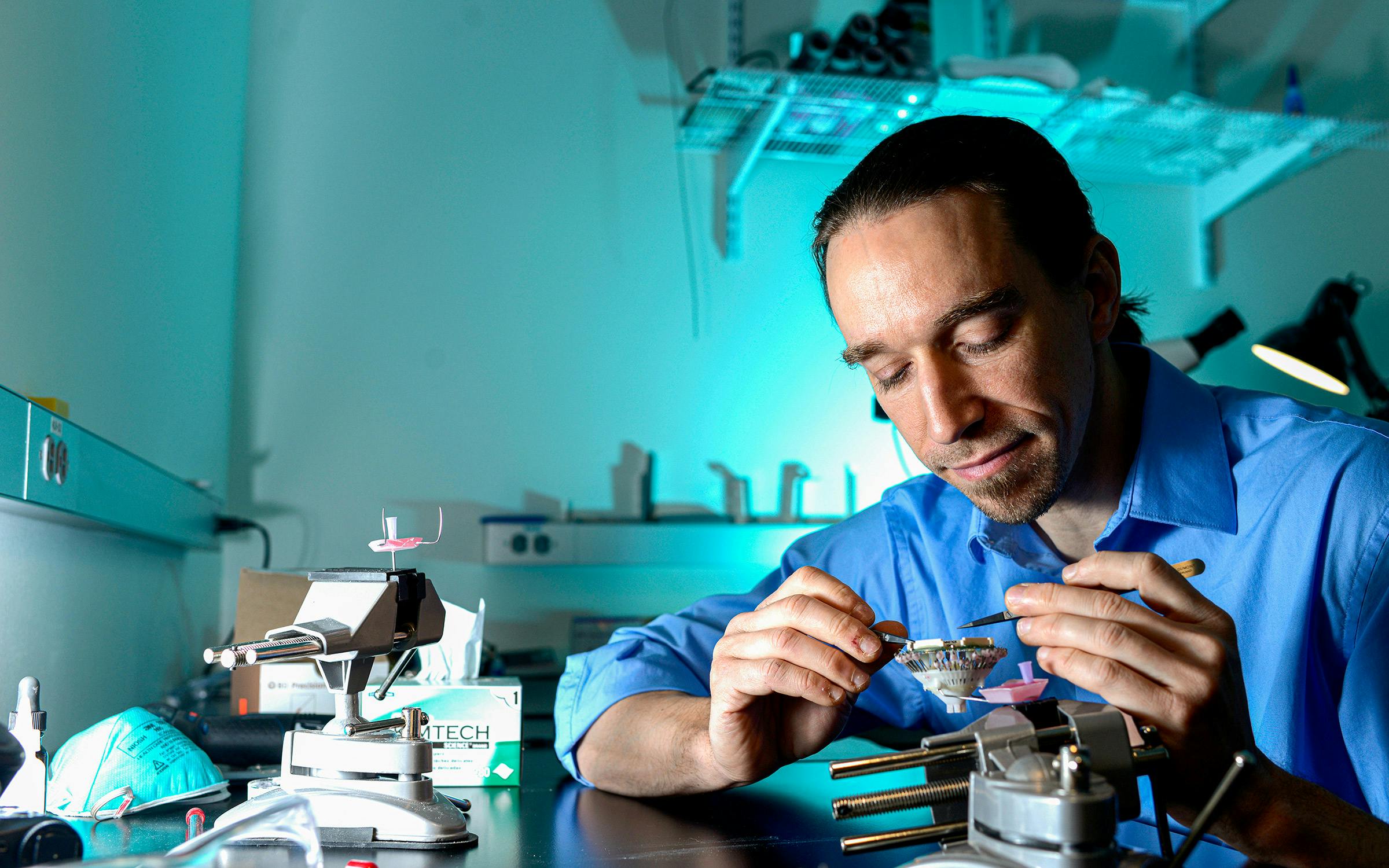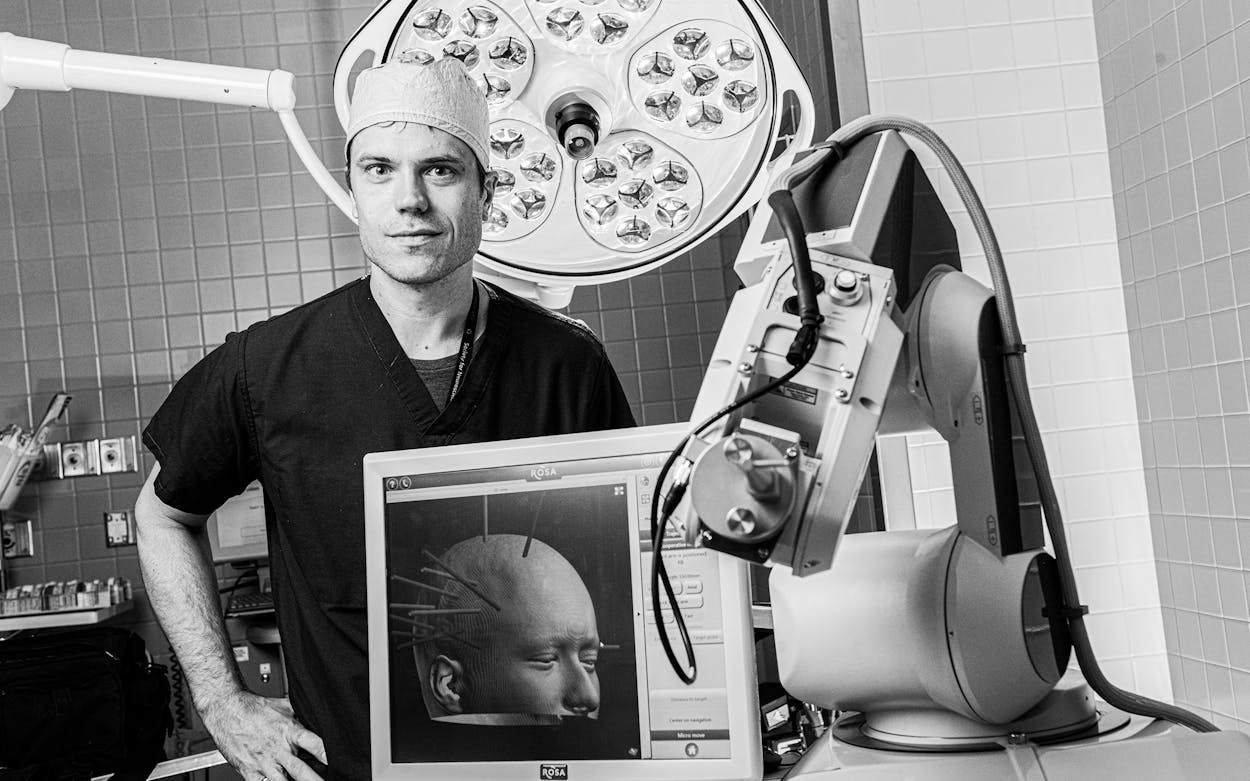We knew something was wrong when my grandfather couldn’t find his way to his favorite spot on Keystone Lake. He’d long known every fishing hole within two hours of Tulsa, Oklahoma, and could reliably catch a stringer full of sand bass before the first rays of sun hit the water. My grandmother had died when they were both in their early seventies, and it became apparent she had been compensating for his memory lapses. He went to live with one of his daughters in Kansas, where he was diagnosed with Alzheimer’s disease. He could still tell vivid stories about his childhood and his service during World War II, but he became increasingly lost in the present. He couldn’t keep track of the day—or even the year. He got lost walking to the neighborhood park. He had trouble remembering the names of his kids and grandkids, so he just called us all darlin’.
Alzheimer’s causes degeneration of the hippocampus, a region of the brain crucial to spatial navigation and orientation, as well as the formation of new memories. (Remote, older memories rely on a different part of the brain and are relatively less affected by the disease.) As you go about your day, several million neurons in your hippocampus are helping to track when and where events take place. “Your brain captures all these little pieces of memory to create mental maps of time and space,” explains Dr. Bradley Lega, an associate professor of neurological surgery at the University of Texas Southwestern Medical Center in Dallas. With that map, you can recall not just random snapshots, but movielike episodes with events in the right place and the right order. “It allows you to put things together so that they make sense.”
When injury or disease damages that map-making region of the brain, people can feel lost in their lives, unable to form memories or piece together a coherent view of their past. Two recent studies from researchers at UT Southwestern’s Peter O’Donnell Jr. Brain Institute have shed new light on how cells in the hippocampus encode information about time and place. Understanding how that brain circuitry works is a necessary first step in devising ways to slow or even reverse the sort of memory loss my grandfather suffered in his final years.
Lega led a team that identified “time cells”—neurons in the hippocampus that activate as events unfold, putting a sort of time stamp on memories. While researchers have known about the existence of time cells in rodent brains for decades, the UT Southwestern study published last month in the journal PNAS is the first to document the presence of time cells in the human brain.
And in a complementary study published in October in the journal Science, Brad Pfeiffer, an associate professor of neuroscience at UT Southwestern, investigated “place cells” that encode information about location as animals (human or otherwise) travel along a path. By analyzing the activity of place cells as rats wandered through a space, Pfeiffer and his team discovered that the rodent brains constantly switched from recalling what just happened to anticipating what would come next.

“We’re now getting these glimpses of a map, but it’s like anything, we need to understand the rules—like the scale and what the different symbols mean—to interpret it,” says Christopher MacDonald, a neuroscience researcher at the Massachusetts Institute of Technology who wasn’t involved in either study. “The more we understand these rules, the better off we’ll be in terms of treatment.”
This work by Lega and Pfeiffer is the latest of several notable advancements to come out of the O’Donnell Brain Institute, including the identification of the big bang of Alzheimer’s disease, the precise moment when proteins in the brain start to form tangles that damage neurons. Researchers there have also made significant progress in gene editing, developing a CRISPR technique that halted the progression of Duchenne muscular dystrophy in dogs. The hope is that doctors will be able to use the same tool to edit DNA in people with the deadly muscle-wasting disease as well as other neuromuscular disorders.
Founded in 2015, the O’Donnell Brain Institute is representative of a surge of deeply funded efforts across the country to advance brain research, propelled by the National Institutes of Health’s BRAIN Initiative. Last year, the institute spent $72 million on research—53 percent more than in 2016—and in the past four years it has expanded its faculty and staff by more than 40 percent, to 2,100. UT Southwestern continues to invest heavily in the institute, which will occupy five floors of a $480 million expansion to the William P. Clements Jr. University Hospital as well as a nine-story research center to open in 2022.
Lega joined the faculty at UT Southwestern seven years ago after spending time in Philadelphia and Chicago. “I’m from Texas, and I was ready to get back home,” he says. It also presented the opportunity to pursue his specialty in surgical treatments for people who suffer from epilepsy and seizures, as well as conduct fundamental scientific research. “When you’re doing that type of surgery, you have an opportunity to learn about the nuts and bolts of the brain and how the gears are turning in terms of cognition.”
For the “time cell” study, Lega and his team placed electrodes in the hippocampi of the brains of 27 adult volunteers who were awaiting surgery as a treatment for seizures. They asked the patients to memorize about a dozen words that were presented on a laptop screen one at a time every couple of seconds. After solving a simple math problem intended as a distraction, patients then were asked to recall as much of the list as possible in thirty seconds. Meanwhile, the researchers were recording electrical activity from individual cells in the volunteers’ brain.
They discovered that certain neurons fired reliably at the same time segments within the allotted thirty seconds—both when people were attempting to memorize the words and later when they tried to recall them. Those time stamps helped people remember both more words overall and more of the list in order.
“Let’s say, I’m a time cell, I fire from two to five seconds on the list,” Lega says. “We found that when I’m doing my job and firing right in my window, the person is able to gather more words into chunks.” That phenomenon is called temporal clustering. “Instead of just remembering a single word at a time, you can remember three or more words together.”
The findings might explain why some people with damage to their hippocampi remember events but have trouble placing those events in the right order. “With Alzheimer’s disease and other neurodegenerative disorders, the ability to remember a sequence of events tends to be one of the first things that is affected,” MacDonald says. “Once we understand memory at this detailed circuit level, we might be able to slow down memory loss or improve the way memories are formed.”
The next step for researchers is understanding how time cells coordinate with other kinds of cells to form a team of cells—called an “ensemble”—that are believed to be key actors in our memories. This would aid in the development of “memory prosthetics,” a promising treatment that involves using a computer to communicate with electrodes placed in the brain. “By delivering tiny electrical pulses through the same kinds of electrodes used to record neuron activity, it may be possible to coax those ensembles to coordinate more harmoniously,” Lega says. “That strategy could help restore memory function in patients suffering from disorders such as traumatic brain injury, mild cognitive impairment, and hopefully Alzheimer’s disease.”
Like Lega, neuroscience researcher Brad Pfeiffer was also happy to get back to Texas. He earned his doctorate from UT Southwestern and returned to Dallas five years ago to join the fledgling O’Donnell Brain Institute, after a stint at Johns Hopkins University. “What was really attractive is that there are a lot of different researchers, each pursuing different questions about how the brain works,” he says. “I have a large number of colleagues to discuss various topics and collaborate with.”
Pfeiffer’s lab studies how rodents use memory by tracking what happens in the animals’ brains when they navigate their environment. In this case, rats turn out to be a good stand-in for humans. “Everything that we’ve learned about how the rat and mouse brain works has been replicated in human studies,” he says.
In his recent Science study, Pfeiffer and his team recorded electrical activity from the hippocampi of rats as, enticed by wells of chocolate milk, they explored a square arena and a long, straight track. Previous research has shown that, like time cells, “place cells” in both animal and human brains fire in sequence to encode different locations along a path.
Mini-sequences of these place cells firing in radarlike sweeps eight to ten times per second are thought to help rats anticipate what lies ahead. Short sequences of neurons also fire in reverse to consolidate the experience into memory. Pfeiffer and his team are the first to demonstrate that forward-looking and retrospective sequences alternate, each taking only a fraction of a second. When the rat stops running, the brain then replays the entire sequence to consolidate the whole path into memory.
“This answers a couple of questions about how the brain may be able to get to the end of a behavioral trajectory and think back about where it just came from,” Pfeiffer says. “Because as the rat is experiencing the world, it’s continually thinking about what’s coming and what it just did.”
Laura Colgin, director of the Center for Learning and Memory at the University of Texas at Austin, says this research contributes to the goal of developing effective memory prosthetics. “We need to be able to decipher the codes carried by hippocampal neuronal signals into meaningful information,” she says. “This work contributes to that effort by revealing the dynamics by which the hippocampus alternates between representing past and future paths.”
To that end, Lega’s work on time cells and Pfeiffer’s on place cells complement one another. “These findings support this emerging view that the brain organizes memories by kind of mapping experiences to a representation of time and space,” MacDonald says.
I wish we’d understood that map when my grandfather was alive, to help him better navigate what must have been an increasingly confusing world. Now middle-aged, I sometimes worry when I forget an appointment or blank on the name of an acquaintance I’ve known for years. The new research offers hope of effective treatments should my own mind eventually start to slip away.
The chance to help chart that future is “the best job in the world,” Lega says. “If you had told me fifteen or twenty years ago that ‘you’re going to do surgery, you’re going to treat people with epilepsy to stop their seizures, and you are going to learn how memory works,’ I’d be like, that is amazing.”
Correction: This story originally misstated the number of floors that the O’Donnell Brain Institute will occupy in an upcoming expansion of the William P. Clements Jr. University Hospital. It has been corrected above.






